Hallway with a carriage coupler: features, design options

The hallway is considered a special room, so the overall impression of the whole dwelling depends on how it is decorated. Since most hallways are small, there are limited opportunities to create interesting designs. A win-win option in this case would be the choice of a classic style with a carriage coupler, which will allow you to create an original interior.


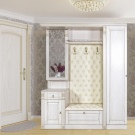

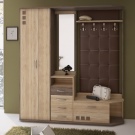

Description
A hallway with a carriage coupler is found in many modern design projects. The main characteristic of this design is the decoration of the walls of the furniture with embossed upholstered capitonné upholstery. You can decorate the surface of hangers, doors, vertical and horizontal wall surfaces in this way. With the help of this design technique, you can create a stunning effect, filling your home with a special atmosphere of comfort.
For the first time in the interior, the technology of such decorative upholstery appeared in the middle of the 18th century in France, when the nobles wanted to emphasize the chic and luxury of their homes. Today the design of the corridor in this design is gaining popularity every year.






To create a carriage tie, expensive textiles, crystals and tight-fitting buttons are used. If furniture and walls are upholstered on their own, then buttons, as a rule, are sheathed with the same material as the surface itself. If the hallways are small, the furniture is finished in light shades, while the soft decor elements should be monochromatic.
The main advantages of the carriage coupler (capitonné) include practicality and a beautiful view. It can be created using various technologies:
- in the classic form with rhombuses;
- with a square harmonious pattern;
- with changing geometry, where there is a decrease or increase in the selected rapport.



Thanks to the capitonné technique, you can safely experiment not only with the seat on chairs, cabinet walls, but also with the surface of the walls, where the volumetric coating can have an abstract, asymmetrical or rectangular shape. If you choose the right relief of the upholstery material, then you can achieve an interesting visual effect, refine the room and visually expand it, filling it with coziness and home warmth.
For example, a corner hallway looks gorgeous, its clear lines harmoniously fit into the overall interior.

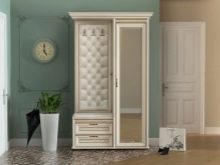

Selection of buttons and fabric
Before you start finishing the corridor with a carriage coupler, you need to choose the right decorative material, which can have a different texture and color. Capitonné in taffeta and silk looks gorgeous, but these fabrics are too thin and cannot withstand the pressure of nails and buttons when trimmed. Therefore, it is best to choose denser materials and an elastic lining. Several types of fabrics are good for decorating hallways.
- Jacquard. It is characterized by a large embossed pattern, looks luxurious in any style and keeps folds well.
- Eco leather... It has high wear resistance, excellent shape retention and easy installation.
- Flock. Pile fabric presented in a chic choice of colors.
- Leather... Refers to durable materials that can last a long time.
- Velours... It is often called velvet fabric, due to its plasticity, deep folds can be created from it.
- Chenille. Refers to natural materials, it is easy to care for and affordable.



As for the carnations, then they should be chosen, taking into account the design features of the room. Furniture buttons look perfect in spacious hallways; they add luxury and sophistication to the interior.
In small-sized corridors, you can decorate surfaces and furniture with natural leather, which is attached with gilded studs.



How to register?
Creating a design with a carriage coupler in the hallway is not particularly difficult, so you can handle it yourself. The main thing is to first carefully prepare the base that you plan to decorate. In rectangular corridors, straight modules are usually installed, which are decorated with vertical panels. You can also arrange furniture horizontally around the entire perimeter, including the upholstery of the front door.
In those places where the fastening will be carried out, you need to make awnings, and install the panel on them. To create soft panels, the base should be given the desired shape, for this it is sanded. Then it is duplicated with foam rubber and padding polyester.

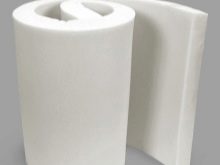

After the base is ready, a sketch of the screed is transferred to it. If such decoration is done for the first time, then the process can be simplified by drawing on a sheet of cardboard, the markings are drawn and applied to the wall of the cabinet, then holes are drilled. This stage ends with the fact that all three layers (synthetic winterizer, foam rubber and plywood) are glued together alternately.
The panels obtained in this way are left to dry for 6-8 hours, and then they begin to create a volumetric pattern. Cuttings of fabric are applied to the panel, and a thread is alternately threaded through the holes, without much effort. It is advisable to start the cladding from the center of the structure, gradually moving towards the edges. Great attention must be paid to the folds between the grooves, which are usually formed from fabric using a thin stick. You can also use strong, narrow cords that are threaded through the holes.
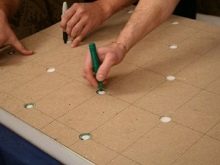


After the decorative structure is made, they begin to fix it to the furniture modules, where hinges are hung in advance and holes are made. If everything is done correctly with strict adherence to technology, you will get a durable and chic finish that will last a long time.Despite the fact that the soft panel at first glance may seem vulnerable to mechanical stress, it is quite capable of withstanding heavy loads.
You can safely lean against such decorative trim, hang clothes and other accessories nearby.

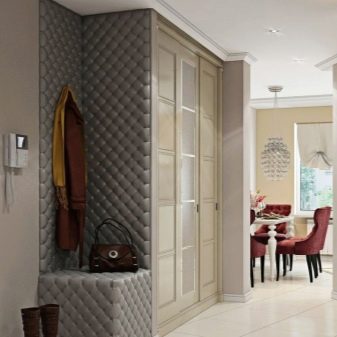
Beautiful examples
Any hallway is a small straight or corner room located directly behind the front door. In order for the guests to have a pleasant impression of all the accommodation, the corridor must have an original and memorable design. For this, there are many options for decorating the interior of the hallways, among which the coach coupler is very popular.
- In straight corridors The carriage coupler will look good on walls measuring 1445x745 mm; additionally, it needs to be placed on the seat of the folding chair and the walls of the cabinet. Volumetric rhombuses should be chosen as patterns; they should match on all decor details. For this, the dimensions of the rhombuses and the indents along their edges are made the same.


- For spacious, straight corridors you can choose any color palette, but it is best to give preference to delicate beige, golden and light brown shades. In small squares, soft panels in the hallways, made of genuine leather, look good, they will harmoniously complement the laminate on the floor.


- In corner hallways it is important to visually create the effect of free space, expanding the boundaries of the room. Therefore, designers recommend such rooms to be decorated in high-tech or minimalism style. The main task in arranging such hallways is to fill the interior with interesting ornaments and geometric patterns, which should be placed both on wall panels and furniture. The facades of furniture items and other decorative details should be covered with matte varnish, and the inner surfaces of the modules should be decorated with a coach tie. Glass shelves and volumetric mirrors will look harmonious with a soft leather screed.


See below for more details.








